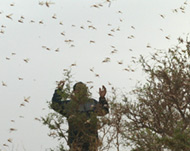African locust plague swarms north
Swarms of desert locusts which have ravaged crops across impoverished West Africa are expected to move north over the coming weeks, the UN Food and Agriculture Organisation (FAO) has said.

But the prospect of a respite is little consolation for farmers in the Senegalese village of Ndande who, like many others in the region, have seen their fields of groundnuts (peanuts) and millet wiped out before they could harvest them.
“We cultivate for three months to feed our families for nine months,” said villager Mamousse Boulibe, standing next to an almost bare field which was full of knee-high groundnut plants until clouds of pink locusts descended on it a few days ago.
“There are people who lost more than this – people who lost 300kg, 500kg, even up to 700kg of groundnuts,” he said. “They’ll have to do other things to feed the family, go to the towns and work.”
Infestation
Villagers said the infestation was even worse than the last big upsurge to hit West Africa more than a decade ago.
The locusts, small enough to perch on the end of a finger but able to form swarms of up to 80 million, were still speckling the sky on Monday around the village some 170km north of the Senegalese capital Dakar.
But experts believe the insects will leave the semi-desert Sahel region in October as vegetation dries up with the end of the rainy season, and head for countries such as Libya, Morocco and Tunisia, while continuing to cause problems in Mauritania.
“They move to greener pastures,” said Keith Cressman, a locust forecasting officer at the Rome-based FAO.
Caution
But he cautioned the locusts could “dine and dash” – devour more crops in West Africa before they fly away.
 |
|
Tiny locusts can form swarms of |
An invasion of southwest Libya by several swarms over the past week heralded further trouble, he said.
“It probably is the first sign of this shift in population,” Cressman said on Tuesday.
Locusts also invaded Mauritania‘s capital Nouakchott at the weekend for the third time in as many months, munching their way through what remained of the city’s greenery.
Mauritania has been hit particularly hard by the crisis and Cressman said he expected the locusts to remain a problem in the northwest of the country, where rain fell recently.
Mali, Niger and Senegal are the other countries worst affected by the locust swarms, which have caused damage over thousands of kilometres in the past two months, from the Atlantic coast to central Africa.